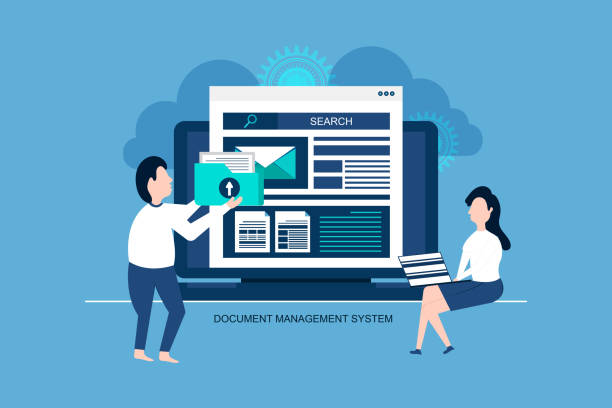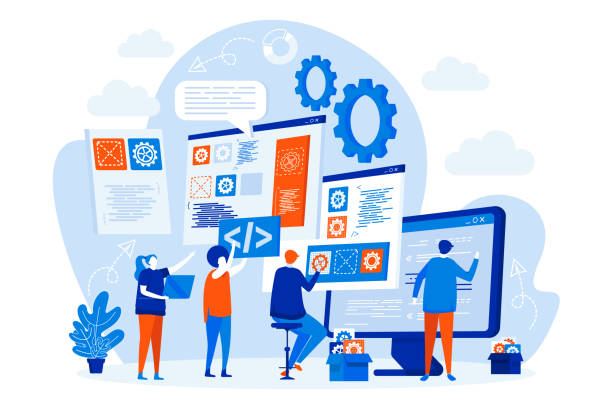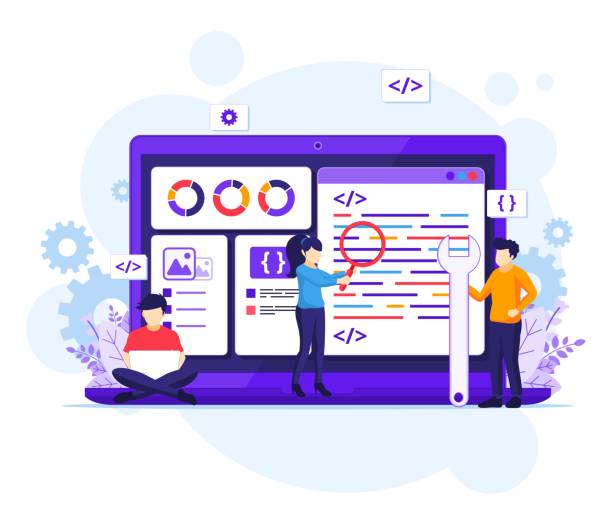Introduction to Digital Content and Its Importance
In today’s world, where the physical boundaries of businesses have faded and the online space has become the main arena for competition, #digital_content is not just a tool, but the backbone of any successful #online_marketing strategy.
From blog posts to engaging videos, informative podcasts, and interactive social media posts, digital content creates a communication bridge between businesses and their audiences.
The main goal of content is to provide value, raise awareness, and ultimately, persuade the audience to take desired actions.
Good explanatory content can simply explain a complex product to the user and guide them towards informed decision-making.
In this era, if a business does not have a strong digital presence, it will practically be eliminated from the competition.
A strong digital presence does not merely mean having a website, but rather consistent and high-quality content production that engages the audience and converts them into loyal customers.
Educational content can introduce users to how to use your products or services and teach them new skills, which in turn adds to your brand’s credibility.
SEO, which refers to #search_engine_optimization, is meaningless without quality content.
Search engines identify relevant and valuable content and rank it higher in results, therefore, strategic content production is a long-term investment for online success.
This content introduces your brand as an authority in your field of activity and builds audience trust.
Don’t have a corporate website yet and missing out on online opportunities? With professional corporate website design by Rasaweb,
✅ Double your business’s credibility
✅ Attract new customers
⚡ Free consultation for your corporate website!
Identifying the Target Audience and Content Needs
Before starting to produce any type of content, a thorough understanding of the target audience is vitally important.
Without this understanding, your content may be aimless and yield no results.
To identify the audience, you need to collect comprehensive information about them.
This process includes demographic analysis (age, gender, location, occupation), psychographic analysis (interests, values, lifestyle), and behavioral analysis (how they interact with content, their problems and challenges).
One of the best methods for this is creating personas or buyer personas.
Personas are semi-fictional profiles of your ideal customers that fully detail their characteristics, goals, problems, and content needs.
For example, guiding content for a teenager might be completely different from that for a retired manager.
By having personas, you can answer questions such as “What problem does this audience have that my content can solve?” or “What kind of content attracts them?”.
Specialized content should be tailored to the knowledge level and specific needs of these personas.
Are they looking for deep and technical information or a simple and practical explanation? Understanding the hidden needs of the audience helps you produce content that is not only relevant but also creates real value for them.
This value can be solving a problem, teaching a skill, or even simply entertaining.
Thought-provoking content can also be very useful for deeper identification of audience needs and challenges, as it makes them think and interact and provides more information about them.
Types of Content and Their Applications in Marketing
Diversity in content production is one of the main keys to success in content marketing.
Each type of content has its specific features and applications and should be utilized depending on the goal and audience.
Blog articles are the heart of written content and are excellent for SEO and providing specialized and explanatory information.
This type of content provides enough space for delving into details and education.
Videos, especially in the current era, are very popular due to their visual appeal and ability to convey information quickly.
Educational, entertaining, and even news videos can significantly increase engagement rates.
Infographics are an excellent way to present complex data visually and understandably, and are ideal for sharing on social media.
Podcasts are audio content that allow content consumption while doing other tasks and are very suitable for specialized and analytical content.
Thought-provoking content on social media increases direct interaction with the audience and can be used to discover new topics of their interest.
E-books and whitepapers provide more specialized and in-depth content that can be used as gate-content to attract leads.
Below is a table of content types and their applications:
| Content Type | Primary Application | Best for |
|---|---|---|
| Blog Articles | Information, Education, SEO | In-depth explanation of concepts, attracting organic traffic |
| Video | Entertainment, Education, Product Introduction | Increasing engagement, product demonstration, branding |
| Infographic | Presenting complex data simply visually | Easy sharing, quick attention-grabbing |
| Podcast | Audio Education, Interview, Analysis | On-the-go access, building trust |
| E-book/Whitepaper | Lead generation, providing specialized information | Attracting serious audience, establishing authority |
| Social Media Posts | Interaction, quick information dissemination, branding | Direct communication with audience, rapid news dissemination |
The choice of content type should be based on your marketing goals and target audience characteristics.
A smart combination of these content types can create a powerful and comprehensive strategy.
Content Planning and Calendar
Successful content production does not merely mean creating brilliant ideas; it requires meticulous and systematic planning.
Without a well-defined content calendar, you might get lost in a whirlpool of repetition, lack of ideas, or even miss important opportunities.
A content calendar is a tool that helps you organize all aspects of your content strategy, from setting overall goals to planning daily content publication.
First, define your goals; are you looking to increase website traffic, improve conversion rates, or raise brand awareness? Then, based on these goals and your understanding of your target audience, start brainstorming various topics.
These topics should be relevant and engaging for your audience.
The content calendar should include details such as: publication date, content title, content type (blog, video, infographic), publication platform, target keywords, production status (drafting, editing, published), and the person responsible for each section.
Guiding and educational content, due to their evergreen nature, should be continuously included in the content calendar.
Consistency in content publication not only signals to search engines that your website is active but also assures your audience that they can count on you for new and valuable content.
This calendar is a dynamic tool that should be regularly updated to align with changes in market and audience needs.
Are you dissatisfied with the low sales of your e-commerce website?
Rasaweb is your solution for having a professional and high-selling e-commerce website.
✅ Significant increase in sales and revenue
✅ Easy and enjoyable shopping experience for customers
⚡ Get a free consultation from Rasaweb now!
Principles of Content Writing and Optimization for SEO
Producing high-quality and engaging content is only half the battle; the other half is optimizing it for search engines (SEO).
No matter how excellent your content is, it will be useless if no one can find it.
SEO ensures that your content is seen by your audience.
The principles of SEO-driven content writing begin with keyword research.
You need to find the words your target audience uses for searching and then naturally incorporate these words into your content.
Avoid excessive keyword density, as this is known as “keyword stuffing” and can harm your ranking.
Content structure is also important: use headings (H1, H2, H3) to organize the text and improve readability.
Keep paragraphs short and use bulleted lists for easy scanning of the text.
Attractive meta titles and meta descriptions containing keywords play a significant role in encouraging users to click on your link in search results.
Images and videos should be accompanied by appropriate Alt tags and detailed descriptions.
Internal linking to other relevant pages on your site and external linking to authoritative sources are crucial for both SEO and adding value to the content.
Specialized and explanatory content that is deep and comprehensive receives more attention from search engines, as it shows you are a reliable authority in your field.
Content readability is as important for users as it is for search engines, and therefore crucial for SEO.
The Role of Images and Videos in Engaging Content
In a world where content is consumed rapidly, visual elements play an exceptionally vital role in attracting and retaining audience attention.
Images, infographics, and especially videos, not only make your content more engaging but can also convey complex information in a simpler and more understandable way.
Research shows that content accompanied by images has a 650% higher engagement rate than purely text-based content.
Videos, due to their ability to tell stories and create emotional connections, are among the most powerful content tools.
Entertaining content, with the help of videos and images, can be highly effective.
When using images, pay attention to their quality, relevancy, and optimization for the web (compression for loading speed).
High-quality images impart a sense of professionalism and credibility to your brand.
Infographics are an excellent tool for converting dry data and statistics into an attractive and shareable visual format, which also enriches explanatory content.
But the king of visual content is video.
From short videos for social media to lengthy webinars and comprehensive educational videos, every format can be valuable.
Videos can attract significant traffic and improve conversion rates.
They also increase user dwell time on the page, which is a positive signal for SEO.
Visual content not only improves user experience but also helps in strengthening your brand and differentiating you from competitors.
Content Distribution and Promotion
Producing great content without a proper distribution strategy is like writing a book that never gets published.
Even the best specialized content needs to be seen.
Content distribution means delivering your content to your target audience through various channels.
Social media networks are one of the most powerful tools for content distribution.
Each platform (Instagram, LinkedIn, Twitter, Telegram) has its unique features, and content should be shared in a format suitable for that platform and its audience.
Email marketing is another very effective channel for distributing news and educational content.
By sending newsletters and regular updates, you can drive traffic to your site and keep your audience engaged.
| Channel | Key Features | Best for |
|---|---|---|
| Blog/Website | Full control, SEO-driven, authority building | In-depth articles, evergreen content, attracting organic traffic |
| Social Media | Virality, direct interaction, brand awareness | Short content, video, infographic, real-time communication |
| Email Marketing | Direct access, relationship building, high conversion rate | Newsletters, special offers, exclusive content |
| Paid Ads | Broad reach, precise targeting, fast results | Rapid increase in visits, specific campaigns, promotional content |
| Influencer Collaboration | Audience trust, access to target community, brand credibility | Product introduction, reviews, awareness campaigns |
Additionally, paid advertising on various platforms and collaboration with influencers or news websites can help increase the visibility of your content.
Publishing news and updated content on news platforms can drive significant traffic to your site.
The selection of distribution channels should be based on where your target audience spends their time.
Content Performance Analysis and Measurement
Producing and distributing content without analyzing its performance is like driving without looking at the speedometer.
To ensure your content strategy is effective and you are reaching your goals, you need to constantly monitor and analyze data.
Google Analytics and other analytical tools provide you with many key metrics.
These metrics include website traffic (number of visitors), bounce rate, time on page, traffic sources (where users came to your site from), and conversion rate.
Analyzing analytical and explanatory content shows which sections of your content generated the most engagement.
For example, if an educational article has a high time on page, it indicates that users found it useful and spent a lot of time reading it.
Conversely, a high bounce rate might indicate a lack of content relevance to user needs or a readability issue.
By examining this data, you can identify the strengths and weaknesses of your content strategy.
This analysis allows you to discover popular topics, successful formats, and efficient distribution channels.
You can also identify the thought-provoking content that had the most engagement and use it to improve your strategy.
Data is your guide to making evidence-based decisions and maximizing the return on investment (ROI) of your content.
Did you know that poor online store design can drive away up to 70% of your potential customers? Rasaweb revolutionizes your sales with professional and user-friendly e-commerce website designs.
✅ Significant increase in sales and revenue
✅ Full optimization for search engines and mobile
⚡ [Get free consultation from Rasaweb]
Content Updating and Repurposing
Content does not reach the end of its life after publication.
In fact, digital content requires continuous updating to remain relevant and fresh, and to maintain its value.
This process is not only beneficial for the audience, who are always looking for new and accurate information, but also crucial for SEO.
Search engines place great importance on fresh and updated content and rank it higher.
Content Repurposing is the art of transforming content into different formats or platforms.
For example, a specialized article can be converted into a podcast, an infographic, several social media posts, or even an educational video.
This not only saves time and resources but also allows you to reach different audiences across various channels with a single piece of content.
Guiding content, whose information may become outdated over time, is the best candidate for updating.
Rewriting parts of the content, adding new statistics, updating links, or adding new sections can breathe new life into it.
This strategy is particularly important for Evergreen Content, which aims to provide stable and long-term information.
By smart repurposing and updating, you can leverage the maximum potential of your content and ensure it always remains accessible and relevant.
Future Trends in Content Production
The digital world is constantly evolving, and the field of content production is no exception.
To remain competitive and stay ahead, understanding future trends is crucial.
One of the most important current and future trends is the role of Artificial Intelligence (AI) in content production.
AI-powered tools can assist in drafting articles, generating engaging headlines, and even optimizing for SEO.
This allows content creators to focus on more creative and strategic aspects of the work.
Interactive content, such as quizzes, surveys, calculators, and augmented reality, is growing due to increased user engagement and the creation of a more personalized experience.
This type of content has a thought-provoking nature and directly engages the audience.
Also, personalized content, which is tailored to the individual preferences and behaviors of the audience, will become increasingly important due to its enhanced effectiveness.
Voice search is also an emerging trend that requires content optimization for short, direct answers.
Finally, with growing concerns about misinformation, the demand for authentic, transparent, and human-centric content will increase.
Brands that can tell their original and honest stories and build genuine connections with their audience will be more successful.
By following these trends and adapting your content strategy accordingly, you can remain relevant and effective in the future.
Frequently Asked Questions
And other services of Rasaweb Advertising Agency in the field of advertising
Smart Marketing Automation: A combination of creativity and technology for customer attraction through key page optimization.
Smart Website Development: Designed for businesses seeking user interaction through custom programming.
Smart Customer Journey Mapping: A quick and efficient solution for digital branding with a focus on Google Ads management.
Smart Advertorial: A professional solution for increasing click-through rates with a focus on attractive user interface design.
Smart Custom Software: A professional solution for analyzing customer behavior with a focus on custom programming.
And over hundreds of other services in the field of internet advertising, advertising consulting, and organizational solutions
Internet Advertising | Advertising Strategy | Advertorial
Sources
Comprehensive Guide to Content Strategy on VirgoolDigital Content Production Strategy for Online Businesses10 Steps to Developing a Successful Content StrategyHow to Have a Successful Online Presence with Content Production?
? To boost your business in the digital world and reach the pinnacles of success, Rasaweb Afarin Digital Marketing Agency, with its expertise in user-friendly website design and innovative online strategies, is your comprehensive solution.
📍 Tehran, Mirdamad Street, next to Bank Markazi, Southern Kazeroon Alley, Ramin Alley No. 6




